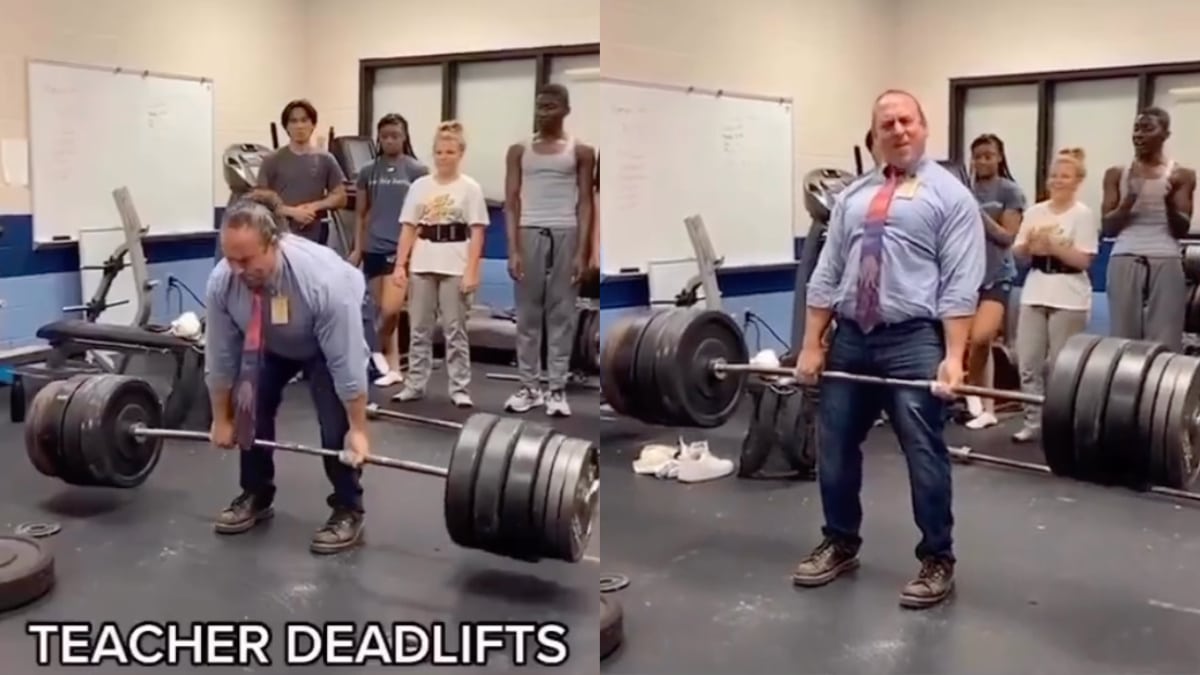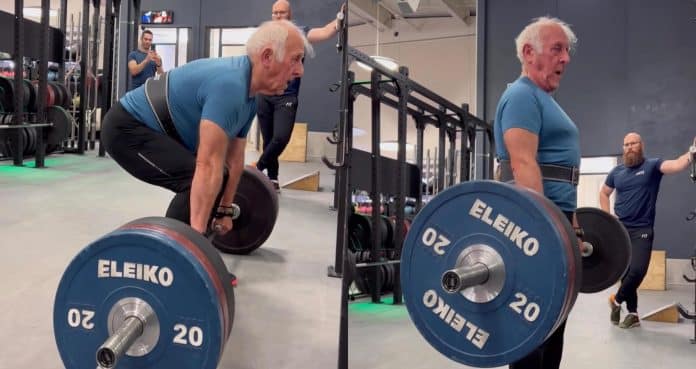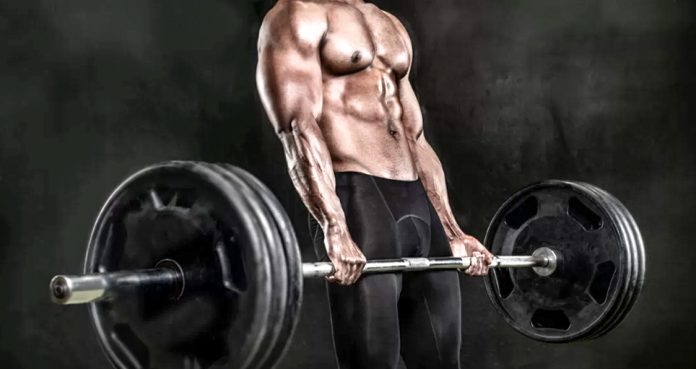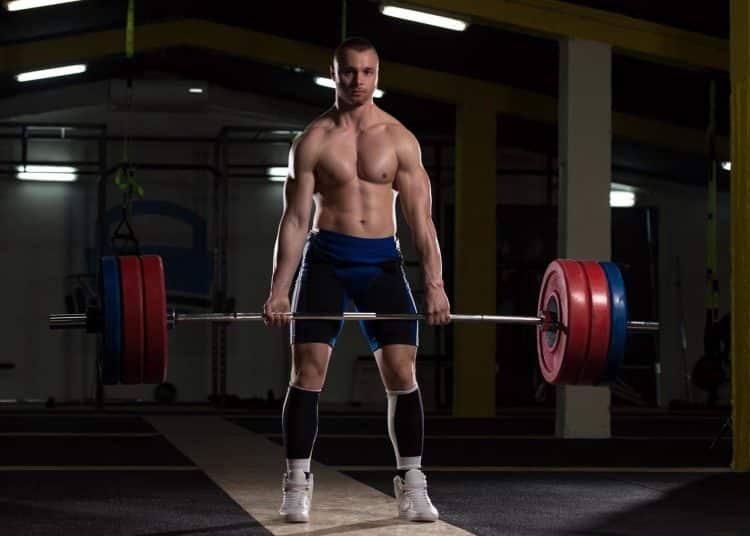Tag: deadlifts

High School Principal Shocks Students with Insane 585-lb Deadlift
The Internet has provided a launching pad for many people for both good and bad reasons. While some find fame through prank videos, others gain attention for their incredible feats of strength. In a recent video posted on Instagram, a high school principal left his students in shock by lifting a huge 585-pound deadlift in the gym.
Deadlifts are one of the most productive exercises one can perform in the training room. The compound movement takes advantage of multiple muscle groups and contributes toward increasing strength in a functional manner. For powerlifters, it’s an essential exercise that they test themselves on along with bench presses and squats. It’s also a staple for strongman athletes.
While professional contenders are expected to inspire others with their heavy lifts, there have been several instances where the inspiration came from unexpected places. In Jul. 2022, a female TikToker influencer named Alice Elizabeth left her fellow gym-goers stunned with her strength after performing a huge 264.5-lb (120-kg) deadlift for six reps. The other male members had a hard time believing how easily she could lift the heavyweight.
Rapper Blueface teamed up with social media fitness influencer Bradley Martyn for a collaborative training session earlier this year. He impressed Martyn in a major way by lifting over 300 pounds on the deadlift.
86-year-old powerlifter Brian Winslow defied his age and crushed the National and World records on the deadlift three months ago. He set the new British and world record by lifting a 171-pound deadlift in the 132 pounds category for ages 85-89 at the 2023 British Drug-Free Powerlifting Championships.
74-year-old Rudy Kadlub celebrated his latest birthday in style by scoring a new PR that would leave even the younger gym-goers envious two months ago. He recorded a massive 524 pounds (237 kilograms) raw deadlift for two reps using the sumo stance.
High School principal shocks students with an insane 585-pound deadlift
In a recent Instagram post, a high school principal left the students in shock after crushing a massive 585-pound deadlift in the school gym. The students applauded after the lift.
The man in the video from last year is Alexander Mercieca of Grissom High School in Huntsville, Alabama. He is an avid fitness enthusiast who is also a certified CrossFit trainer. He continues to train hard and lifted an impressive 550-pound deadlift for three reps with ease five weeks ago.
Reactions from the fitness community came pouring in on the clip. While many praised the man for his feat of strength, some found areas to criticize regardless.
“Teaching the students a thing about lifting,” the post captioned.
“No belt straps or even right clothes,” noted a user.
“W teacher,” wrote one.
“Only belt is to hold his pants up,” commented a user.
“No belt, no wraps, jeans and a tie….. BEAST!!!” wrote another.
“Maybe he could teach them to set the bar back down instead of dropping it,” criticized one.
“Impressive, but can he teach,” criticized another.
“He can absolutely do more,” wrote a user.
One responded, “If you can pick this up, you get an ‘A.’”
“The dad strength displayed is unreal,” commented a poster.
Read also World’s Heaviest Deadlift Performances of All Time
Legendary rapper Method Man, real name Clifford Smith Jr., of the iconic hip-hop group Wu-Tang Clan, encouraged his massive fanbase with a workout update by performing heavy deadlifts at the age of 52 last month.
Fitness fans took motivation from 73-year-old powerlifter Mary Duffy who managed to smash a 310-pound deadlift, over 2.5x her body weight, with chains in a training session weeks ago.
Speaking of deadlifts, Inderraj Singh Dhillon set a new IPF deadlift World Record of 851 pounds (386-kg) in the. 120-kg weight class at the 2023 IPF World Classic Open Powerlifting Championships a few days ago. Farhanna Farid achieved a similar feat after pulling a 447.5-pound (203-kg) raw deadlift in the 52-kg category to set a new all-time World Record at the same event.
The school principal’s resurfaced clip would surely give a dose of motivation to many considering the weight he lifted at an old age.
Related:
Published: 21 June, 2023 | 3:42 PM EDT

Norwegian Man Hits PR Deadlift Of 330.7 Pounds On 80th Birthday
A Norwegian man identified as Magne set a new deadlift PR with a huge lift on his 80th birthday.
There are many examples shown each day that age is just a number. Now, another has come courtesy of a man identified as Magne, an 80-year-old man who recently hit a new PR in the gym. He completed a 150kg (330.7lb) deadlift on his 80th birthday.
The video was shared on Sats Norge’s official Instagram page. The Norwegian training group shared a video of Magne on his birthday and shared his inspiring story.
In the caption, it was explained that Magne has been working toward his goal of a 150kg deadlift. He has been working to build strength to take care of his wife, who is physically handicapped. Magne wants to build strength so his wife can continue to live with him.
“This is our raw member Magne who is 80 years old today! He has long worked towards the goal of lifting 150kg in deadlift on his 80th birthday, with love as a motivation.”
“His wife is physically handicapped, and Magne is there fore training to be strong enough to help her so that she can continue to live at home. Together with his PT Therese, he has made a plan to achieve the goal – and today, on his 80th birthday, he did it! We are so moved and inspired.”
Magne’s incredible deadlift adds to many other impressive lifts seen by older weightlifters. John LaFlamme comes to mind because of the strength he has been able to maintain. He has been seen squatting upwards of 430 pounds at 71 years old.
The story of Magne is inspirational because of the reason he is working out. He is working to take care of his wife and this is a great story involving the gym. It will be interesting to keep an eye on if Magne continues to improve his numbers and sets a new goal for his deadlifts.
For more news and updates, follow Generation Iron on Facebook, Twitter, and Instagram.

16 Squat and Deadlift Variations You Should Know About
Squat and Deadlift Variations You Should Know About
Squat and deadlifts are two of the most dominant compound exercises. These two exercises are also some of the most functional movements. You’ll find these exercises in almost every kind of training discipline be it bodybuilding, powerlifting, CrossFit or any other.
Performing the vanilla squats and deadlifts can cause you to hit a plateau. A great way to break through the glass ceiling is to try new variations of the exercises. There are enough variations of these exercises to keep you entertained for months.
Squats
Back Squats
Back squats are the conventional and most common type of squats. Based on your mobility, you could perform all types of squats with a high or low bar position. In the high bar position, the barbell sits on your traps, and in the low bar position, the barbell is placed on your shoulder blades.
[embedded content]
Front Squats
In the front squats, you place the barbell across the front side of your shoulders. The front squats are quad dominant as you need to maintain an upright position throughout the exercise.
[embedded content]
Box Squats
If you’re don’t have the mobility and are not comfortable going ass-to-grass in the conventional squats, the box squats can help you by squatting to the desired depth and develop explosive strength in the squat movement.
Sumo Squats
Sumo squats are wide-stance squats which primarily target the hams, glutes and inner thighs. The range of motion while performing the sumo squats is considerably smaller as compared to the conventional squats.
Narrow Stance Squats
Narrow stance squats are the opposite of sumo squats. In this variation, you have to place your feet next to each other. Doing so targets your outer thighs and helps in building the outer quad sweep.
Frankenstein Squat
Frankenstein squats are an advanced level squat variation. To perform the Frankenstein squat, you need to extend your arms straight forward and place the barbell on the “shelf” created in your shoulders. The Frankenstein squat teaches you the proper positioning of both the bar and your body during the clean and front squat.
Goblet Squat
If you’re suffering from a back injury and are not comfortable performing the barbell squats, the goblet squats can be a lifesaver. Hold a dumbbell next to your chest while performing the squats to target your quads.
Zercher Squat
Zercher squat involves holding the barbell between the crook of your elbow while squatting. The Zercher squat increases glute and quad activation. It improves the front squat and even works the biceps.
Deadlifts
Conventional Deadlifts
Conventional deadlifts are the most common type of deadlifts which involves standing with a shoulder width stance and holding the barbell with a shoulder-wide snatch or a mixed hand grip.
[embedded content]
Sumo Deadlifts
Sumo deadlifts have the same feet placement as the sumo squats. The sumo deadlifts take your legs out of the equation and primarily focus on the upper back. Hold the barbell with a mixed hand grip while performing the sumo deadlifts.
[embedded content]
Deficit Deadlifts
Deficit deadlifts are for the more advanced lifters as it includes standing on an elevated surface (weight plates or a hard aerobic stepper) while performing the deadlifts. Standing on the weight plates increases the range of motion which makes the movement harder than the conventional deadlifts.
Rack Pulls Deadlifts
In the rack pull deadlifts, you lift the bar off the safety pins in a squat rack. This variation of deadlifts is great for people who have back problems and can’t perform any other type of deadlifts. You can adjust the range of motion of the movement by setting the height of the safety pins.
Trap Bar Deadlifts
Trap bar deadlifts target the traps and the upper back. In the trap or hex bar deadlifts, you hold the barbell at your sides which makes the movement easier. You should be able to move heavier weights while performing the hex bar deadlifts.
Romanian Deadlifts
Romanian deadlifts or stiff-legged deadlifts target the hamstrings. Stand with a barbell in hands and your knees locked at a slight angle. Push your hips back as you lower the barbell and contract your hamstrings. Pause at the bottom for a second and return to the starting position.
Snatch Grip Deadlifts
In the snatch grip deadlifts, your hands take on a wide grip where they are almost touching the sides of the weight plates on the barbell. The snatch deadlift is a type of Olympic lift which mainly works the hamstrings. It acts to strengthen the pull of the snatch.
Dumbbell Deadlifts
Some people are not comfortable performing the deadlifts with a barbell. The dumbbells can improve the range of motion and the resulting pump as you have better mobility with them as compared to the barbell.
Have you tried all the variations of the squats and deadlifts mentioned above? Let us know in the comments below. Also, be sure to follow Generation Iron on Facebook and Twitter.
*Header image courtesy of Envato Elements.

Larry Wheels Sets Deadlift PR With 7 Reps of 347kg
Larry Wheels has continued his work in the gym by setting another PR.
Larry Wheels has been putting in some serious work in the gym in recent months. We know this because he shares frequently on social media displaying different lifts and personal records. This continued on Monday as Wheels set a new PR performing seven reps of 347kg (765lb) deadlifts.
Wheels stepped over the weight wearing a lifting belt and straps. He performed the first four reps with ease before struggling a bit with No. 5. Wheels was able to power through two more reps to make a total of seven. Wheels posted the entire set on Instagram.
“765/347 x7 rep PR. Haven’t deadlifted in 2 months. Rest can do wonders!@teampersonalrecordLifting straps SWIPE@levansaginashvili“
This is not the first PR that Larry Wheels has achieved in recent weeks. On Oct. 29, he performed 17 shoulder press reps with a 140-pound dumbbell in each hand. Just weeks before that, Wheels set a new PR with a 950-pound squat. Now, Wheels has taken on deadlifts, which is something he has not been doing recently. This record squat came before he suffered a quad injury and was forced to take some time off.
In the caption with the video, Wheels shares that he has not deadlifted in two months. He credits the needed rest for being able to pull off a feat such as this. This is important for Wheels given the fact that he has suffered his fair share of injuries over the years. He felt as strong as ever attempting this set of deadlifts after the time off.
Larry Wheels has been injured in the past performing deadlifts. This came earlier in the year when he was hurt while moving an enormous weight back to the floor. At the Strong Gym in Dubai, Wheels completed three reps of 387kg (855lb), which is another PR of his. While performing a backdown set, Wheels strained his back on the way down.
While Wheels set a new PR with seven reps, this was not his all-time heaviest deadlift. That came with a single rep of 419kg (924lb).
Larry Wheels has turned into a PR monster who is always trying to improve his numbers in the gym. It is always exciting to wait and see which lifts he takes on next.
For more news and updates, follow Generation Iron on Facebook, Twitter, and Instagram.

How to Find The Best Deadlift Grip For You?
One of The Best Exercises Deadlifting is probably one of the best exercises for gaining muscle and overall strength. The exercise strengthens your laps, trapezius, thighs, abs, and biceps. Now, there are several ways how one can perform a deadlift. In this article, we will discuss how to find the best deadlift grip for you. […]
The post How to Find The Best Deadlift Grip For You? appeared first on What Steroids.

